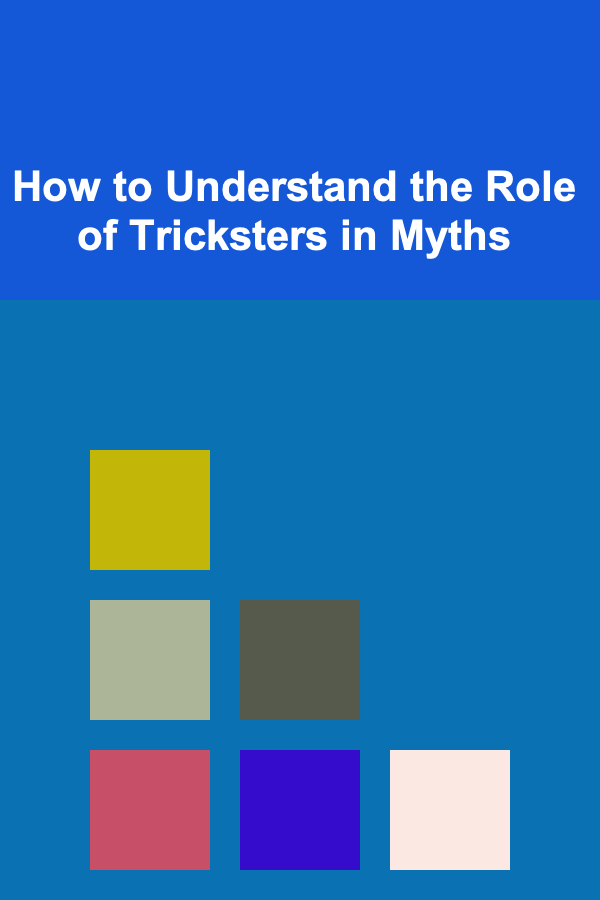
How to Understand the Role of Tricksters in Myths
ebook include PDF & Audio bundle (Micro Guide)
$12.99$5.99
Limited Time Offer! Order within the next:

Tricksters have long held a captivating role in mythologies across various cultures around the world. These figures, often mischievous, deceptive, and cunning, are integral to the storytelling traditions of many civilizations. From ancient Greek mythology to African folklore, tricksters are complex characters who challenge the status quo, break boundaries, and ultimately reveal deep insights into human nature, culture, and society. To understand the role of tricksters in myths, one must delve into their characteristics, significance, and the multifaceted impact they have on the development of the mythic narrative.
Defining the Trickster Archetype
The trickster archetype is defined by several key characteristics that make it both fascinating and challenging. Tricksters are often portrayed as shape-shifters, able to change their appearance or identity to suit their needs or deceive others. They thrive on chaos, unpredictability, and cunning, and often play the role of a disruptor within the mythic structure. However, their actions typically serve a greater purpose, whether it's providing lessons, catalyzing change, or exposing the flaws of the system they challenge.
Some of the most common traits of tricksters in myths include:
- Deception and Cleverness: Tricksters are adept at using their wit and intelligence to outsmart others. They deceive gods, heroes, and ordinary people, often for personal gain or amusement.
- Transgression of Boundaries: Tricksters frequently break societal, moral, and even cosmic rules. They disregard conventions, question authority, and push the limits of what is considered acceptable.
- Dual Nature: Tricksters can be both comical and malevolent, reflecting the duality of human nature. They can be playful and lighthearted, or they can cause harm, depending on their motivations and the context of the myth.
- Catalysts for Change: While tricksters often appear disruptive or destructive, their actions can bring about necessary transformation. They challenge existing structures, expose flaws, and sometimes even bring balance or justice.
- Transformation and Shape-shifting: Tricksters are often associated with the ability to change form. This can be literal, as in the case of shape-shifting gods, or metaphorical, representing the fluidity of identity and the breaking of rigid societal categories.
While tricksters are often seen as subversive or even chaotic, they are crucial for the evolution of myths, offering lessons about the complexities of human nature, morality, and the necessity of change.
Tricksters in Various Cultures
Greek Mythology: Hermes and Prometheus
In Greek mythology, the role of tricksters is exemplified by gods like Hermes and Prometheus. Hermes, the messenger god, is known for his quick wit, cunning, and ability to deceive. He is often portrayed as a playful, mischievous figure who outsmarts other gods and mortals alike. Hermes' trickster nature is evident in several myths, such as his theft of Apollo's cattle shortly after his birth, a feat accomplished through cunning and resourcefulness. Hermes' role as a trickster reflects the balance between wit and wisdom, as he uses his intelligence to outmaneuver others, often for the benefit of humanity.
Prometheus, another prominent figure in Greek mythology, embodies the trickster archetype in a more rebellious and self-sacrificial way. While Prometheus' primary role is that of a benefactor to humanity---giving them fire---he also acts as a trickster by defying Zeus, the king of the gods. Prometheus tricks Zeus by deceiving him during a sacrifice, which leads to his punishment. His trickery challenges the authority of Zeus and brings about both suffering and progress for humanity, symbolizing the dual nature of tricksters as both creators and disruptors.
Native American Mythology: Coyote and Raven
In Native American mythology, tricksters often take the form of animals, with Coyote and Raven being two of the most famous examples. Coyote is a central figure in many Native American stories, particularly among tribes like the Navajo and Lakota. Coyote is both a creator and a destroyer, embodying the characteristics of a trickster in his actions. He often causes chaos through his foolishness or selfishness, but his actions also lead to important lessons about the consequences of one's behavior and the unpredictable nature of the world. Coyote's tricks often teach humility, the importance of balance, and respect for nature.
Raven, on the other hand, is revered as a cultural hero and trickster in the mythology of several North American indigenous groups, including the Haida and Tlingit peoples. Raven is often depicted as a shapeshifter, capable of transforming into different creatures and influencing the world through his tricks. In many myths, Raven is responsible for bringing light to the world, shaping the landscape, and even creating humans. However, his actions often come with unintended consequences, highlighting the complexity of tricksters as figures who bring both benefits and drawbacks to society.
African Folklore: Anansi the Spider
Anansi the Spider is one of the most well-known trickster figures in African folklore, particularly in the West African and Caribbean traditions. Anansi is often depicted as a clever, resourceful spider who uses his intelligence to outwit stronger, more powerful creatures. Through his tricks, Anansi is able to gain wisdom, food, or other resources, often at the expense of other animals or gods. Anansi's tales serve as both entertainment and moral lessons, teaching the value of wit and resourcefulness, as well as the consequences of greed and arrogance.
Anansi's trickster nature also embodies the importance of storytelling itself. As a spider, he is often associated with weaving tales and weaving the web of life, reinforcing the idea that tricksters are not only disruptors but also creators of stories that reflect the deeper truths of the world.
Hindu Mythology: Krishna and the Asuras
In Hindu mythology, the role of the trickster is often played by deities like Krishna, who is known for his playful nature and cunning strategies in defeating the demons, or Asuras. Krishna's trickster characteristics are most famously displayed in the Mahabharata, where he uses his intelligence and charm to manipulate situations in favor of the Pandavas, the heroes of the epic. One of the most famous examples of Krishna's trickery is his role in the Kurukshetra War, where he uses both diplomacy and deception to bring about the defeat of the Kauravas.
Krishna's trickster qualities serve to challenge the notions of good and evil, highlighting that morality is often fluid and that strategic thinking and compassion can be used to overcome adversity. His actions also emphasize the importance of dharma (righteous duty), showing that even the most cunning tricks can serve a higher moral purpose.
Norse Mythology: Loki
Loki, the trickster god in Norse mythology, is one of the most famous and multifaceted trickster figures. Loki's role in the myths is ambiguous; he is neither purely good nor purely evil. He causes trouble for the gods of Asgard, often through deceit, shapeshifting, and manipulation. One of Loki's most famous tricks is his involvement in the death of the beloved god Balder, which ultimately leads to the events of Ragnarök, the apocalyptic destruction of the gods.
Loki's trickster behavior reflects the Norse worldview, which embraced the inevitability of chaos and destruction. While his actions bring about suffering, they also play a necessary role in the larger cosmic order. Loki's role highlights the idea that tricksters, despite their disruptive nature, are often integral to the cycles of life, death, and rebirth.
The Psychological and Cultural Significance of Tricksters
Tricksters play an essential role in the psychology of myths, offering insights into the unconscious mind and the human condition. Their behaviors and actions often symbolize the parts of ourselves that we repress or neglect---our desires for freedom, rebellion, and self-expression. The trickster's ability to transcend societal norms and boundaries speaks to a fundamental aspect of human nature: the desire for autonomy and self-determination.
In many ways, tricksters represent the shadow aspect of the psyche, as described by psychologist Carl Jung. The shadow consists of the traits, impulses, and desires that we hide from the world and even from ourselves. Tricksters, by breaking societal norms and playing with moral boundaries, embody these hidden aspects, challenging individuals to confront their own inner contradictions and unresolved tensions.
Culturally, tricksters often act as catalysts for social change. By transgressing established norms, they bring attention to the flaws within society, urging people to question authority and the status quo. Tricksters provide an outlet for the expression of dissatisfaction and rebellion, offering a way for individuals and communities to address social issues without directly confronting them in an overt manner. In this way, tricksters help to maintain the balance between tradition and innovation, ensuring that societies remain flexible and responsive to change.
Conclusion
Tricksters are among the most captivating and complex figures in mythological traditions around the world. Their role is not merely to cause disruption or to entertain, but to challenge, transform, and reveal the deeper truths of the human experience. Whether as cunning gods, shape-shifting animals, or wise beings, tricksters play an integral part in the evolution of myths, reflecting the ever-present tension between order and chaos, good and evil, tradition and change. By embracing their dual nature, tricksters provide valuable lessons about the complexity of life, encouraging individuals and cultures to adapt, learn, and grow in the face of adversity. Ultimately, the trickster reminds us that life is not always about adhering to rigid norms but about navigating the unpredictable and ever-changing landscape of existence with creativity, wit, and resilience.

How to Build a Checklist for Organizing Your Garage or Storage Space: A Comprehensive Guide
Read More
How to Diversify Your Investments to Protect Against Inflation
Read More
How to Set the Mood with Party Decor: Tips and Tricks
Read More
How to Bake Healthy Muffins and Scones
Read More
Mastering Pinterest Marketing for Print-on-Demand (POD)
Read More
How to Use a Credit Card to Build an Emergency Fund (Carefully)
Read MoreOther Products

How to Build a Checklist for Organizing Your Garage or Storage Space: A Comprehensive Guide
Read More
How to Diversify Your Investments to Protect Against Inflation
Read More
How to Set the Mood with Party Decor: Tips and Tricks
Read More
How to Bake Healthy Muffins and Scones
Read More
Mastering Pinterest Marketing for Print-on-Demand (POD)
Read More